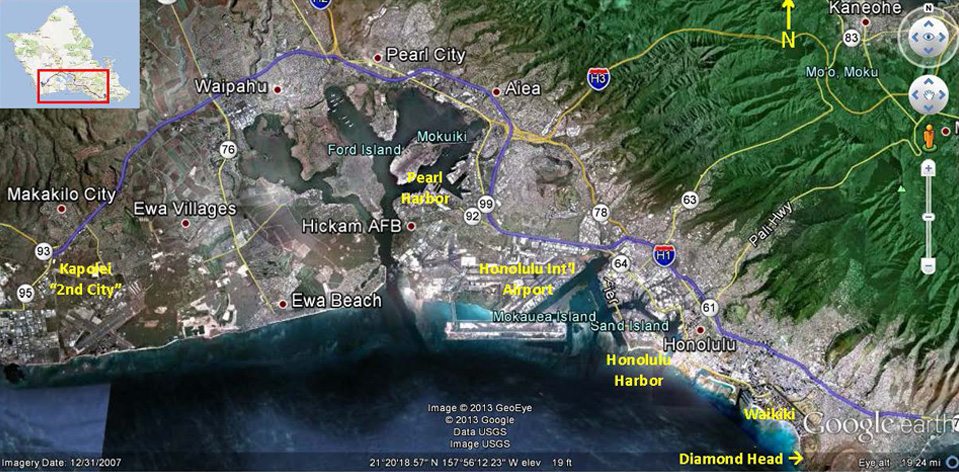Services Provided
Civil Engineering
Planning
Traffic Engineering
Client
State of Hawaii, Dept. of Transportation, Highways Division, Planning Branch
Location
Island of Oahu, Various locations, Honolulu, Hawaii
Project Type – Markets
Highways/Roads/Bridges
Interstate Route H1 Corridor Study
The State Department of Transportation wanted a comprehensive review of the current conditions and future needs along the Interstate H-1 through O‘ahu. The assignment was to identify and prioritize projects that would improve safety, mobility, and would preserve system maintenance. The Department recognized that H-1 is 23 miles long and it is critical to commuting, goods movements and all aspects of life in the State. Over half of Oahu’s population lives along this corridor and depends on it for daily travel. The Department wanted a study grounded in analysis and data that captured all aspects of this essential road. They wanted the study to lay out a phased action program for consideration by the department engineers, as well as lay person decision-makers.
More / Less
SSFM was selected to develop the strategic framework for the H-1 Corridor Program. The approach entails 4 phases.
Phase 1: Identified key transportation problems on the 23-mile interstate corridor. Because the road traverses all major economic, social and residential activities on O‘ahu, it was important to develop a full range of evaluation criteria based on national and local objectives. 110 potential projects were identified. SSFM developed a system based on federal laws for displaying options as well as efficiently and effectively evaluating performance metrics for 23 criteria.
Phase 2: Included data collection and analysis of the candidate improvements with future year (2035) assessments based on the regional transportation model. Types of data collection included traffic counts by segment, speed and bottleneck data using INRIX Analytical Tools, and traffic observations. Eighty projects underwent detailed evaluation of their expected traffic performance.
Phase 3: Projects were reviewed for their transportation benefits and costs based on assessments prepared by SSFM and its sub-consultants. Projects were placed into packages for programming and implementation.
Phase 4: The final phase includes feasibility reviews of environmental, constructability, socio-economic benefits and impacts, and community acceptance. This phase examined the economic and social value H-1 to both Oahu and Hawai‘i which helps to ground its importance in budgeting. This phase entailed comprehensive technical analyses of economic and social impact to be reviewed by internal and external stakeholder groups.
Benefit and costs are compared to the MOE performance measures. Priorities are established for funding. A Final Report will create the implementation strategies for selected projects.


Interstate Route H1 Corridor Study
The State Department of Transportation wanted a comprehensive review of the current conditions and future needs along the Interstate H-1 through O‘ahu. The assignment was to identify and prioritize projects that would improve safety, mobility, and would preserve system maintenance. The Department recognized that H-1 is 23 miles long and it is critical to commuting, goods movements and all aspects of life in the State. Over half of Oahu’s population lives along this corridor and depends on it for daily travel. The Department wanted a study grounded in analysis and data that captured all aspects of this essential road. They wanted the study to lay out a phased action program for consideration by the department engineers, as well as lay person decision-makers.
More / Less
SSFM was selected to develop the strategic framework for the H-1 Corridor Program. The approach entails 4 phases.
Phase 1: Identified key transportation problems on the 23-mile interstate corridor. Because the road traverses all major economic, social and residential activities on O‘ahu, it was important to develop a full range of evaluation criteria based on national and local objectives. 110 potential projects were identified. SSFM developed a system based on federal laws for displaying options as well as efficiently and effectively evaluating performance metrics for 23 criteria.
Phase 2: Included data collection and analysis of the candidate improvements with future year (2035) assessments based on the regional transportation model. Types of data collection included traffic counts by segment, speed and bottleneck data using INRIX Analytical Tools, and traffic observations. Eighty projects underwent detailed evaluation of their expected traffic performance.
Phase 3: Projects were reviewed for their transportation benefits and costs based on assessments prepared by SSFM and its sub-consultants. Projects were placed into packages for programming and implementation.
Phase 4: The final phase includes feasibility reviews of environmental, constructability, socio-economic benefits and impacts, and community acceptance. This phase examined the economic and social value H-1 to both Oahu and Hawai‘i which helps to ground its importance in budgeting. This phase entailed comprehensive technical analyses of economic and social impact to be reviewed by internal and external stakeholder groups.
Benefit and costs are compared to the MOE performance measures. Priorities are established for funding. A Final Report will create the implementation strategies for selected projects.
Services Provided
Civil Engineering
Planning
Traffic Engineering
Client
State of Hawaii, Dept. of Transportation, Highways Division, Planning Branch
Location
Island of Oahu, Various locations, Honolulu, Hawaii
Project Type – Markets
Highways/Roads/Bridges
